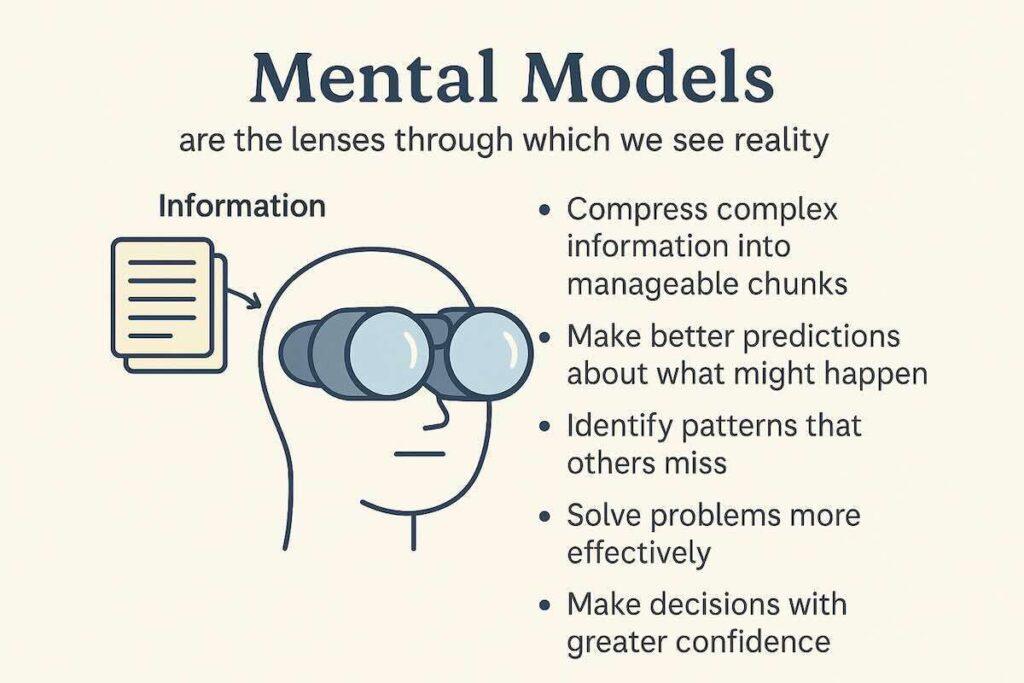These models give you an edge in solving problems and understanding the world. You’ll learn about mental models in this guide. You’ll see how they work and how to use them in business, science, and life.
What Are Mental Models?
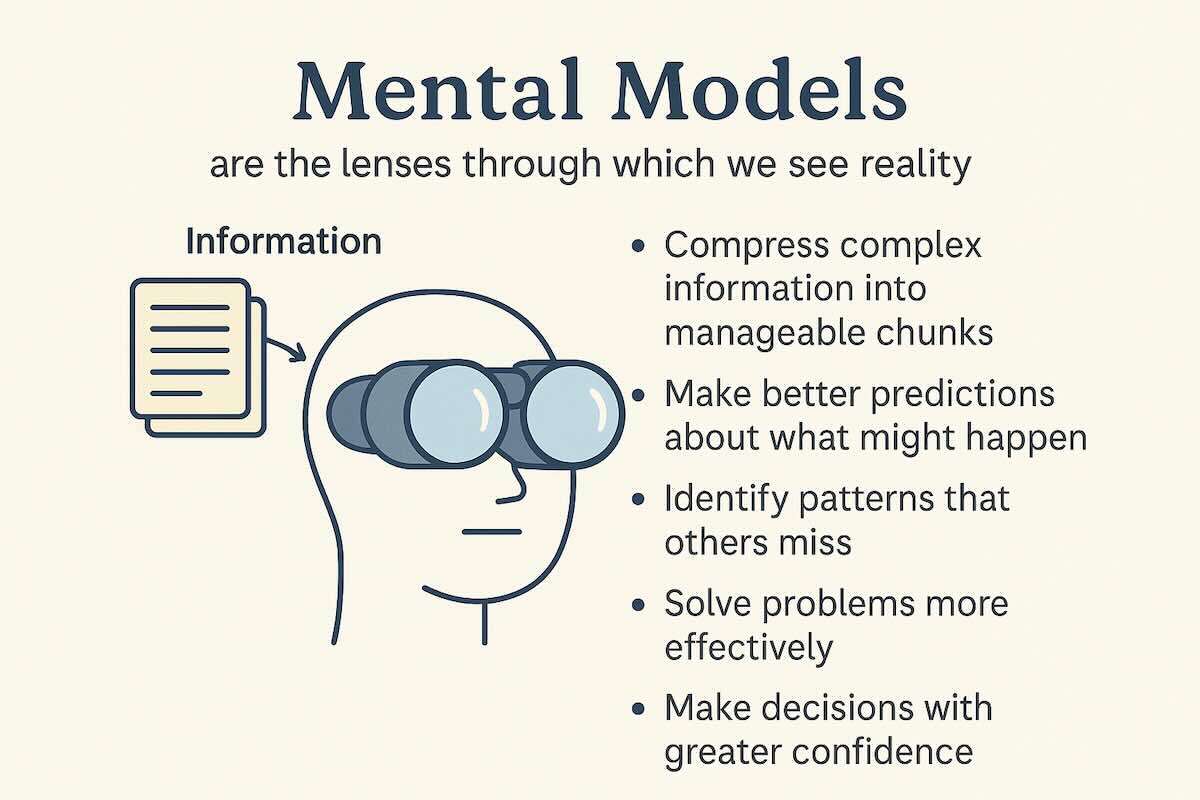
Mental models act as filters that help us make sense of complex information
A mental model is a simplified explanation of how something works in the world. Think of it as a personal thinking tool that helps you understand the way people perceive things.
Just as maps help us navigate physical terrain over time, mental models help us navigate the complexity of life by highlighting what’s important and filtering out irrelevant details from the book of experiences. Things become clearer.
Mental models are the lenses through which we see reality. They’re the thinking tools that help us:
- Compress complex information into manageable chunks
- Make better predictions about what might happen
- Identify patterns that others miss
- Solve problems more effectively
- Make decisions with greater confidence
The power of mental models comes from their versatility. Rather than having one specialized way of thinking, having multiple mental models gives you a variety of tools to approach any situation.
As the saying goes: “To a hammer, everything looks like a nail.” But when you have a complete toolkit, you can select the right tool for each job.
“You can’t really know anything if you just remember isolated facts. If the facts don’t hang together on a latticework of theory, you don’t have them in a usable form.”
Key Mental Models That Improve Decision-Making
Mental models become more powerful when you see how they’re used in real life. Here are seven key models that top performers use. They help make better decisions, grasp complex systems, and think more clearly.
These aren’t just theories from school. They’re practical tools for everyday life and work.
7 Powerful Mental Models to Improve Your Thinking
Let’s explore seven of the most versatile mental models that can transform how you approach problems and make decisions. These models come from diverse fields including physics, economics, and biology, but each offers valuable insights that extend far beyond its original domain.
1. First Principles Thinking
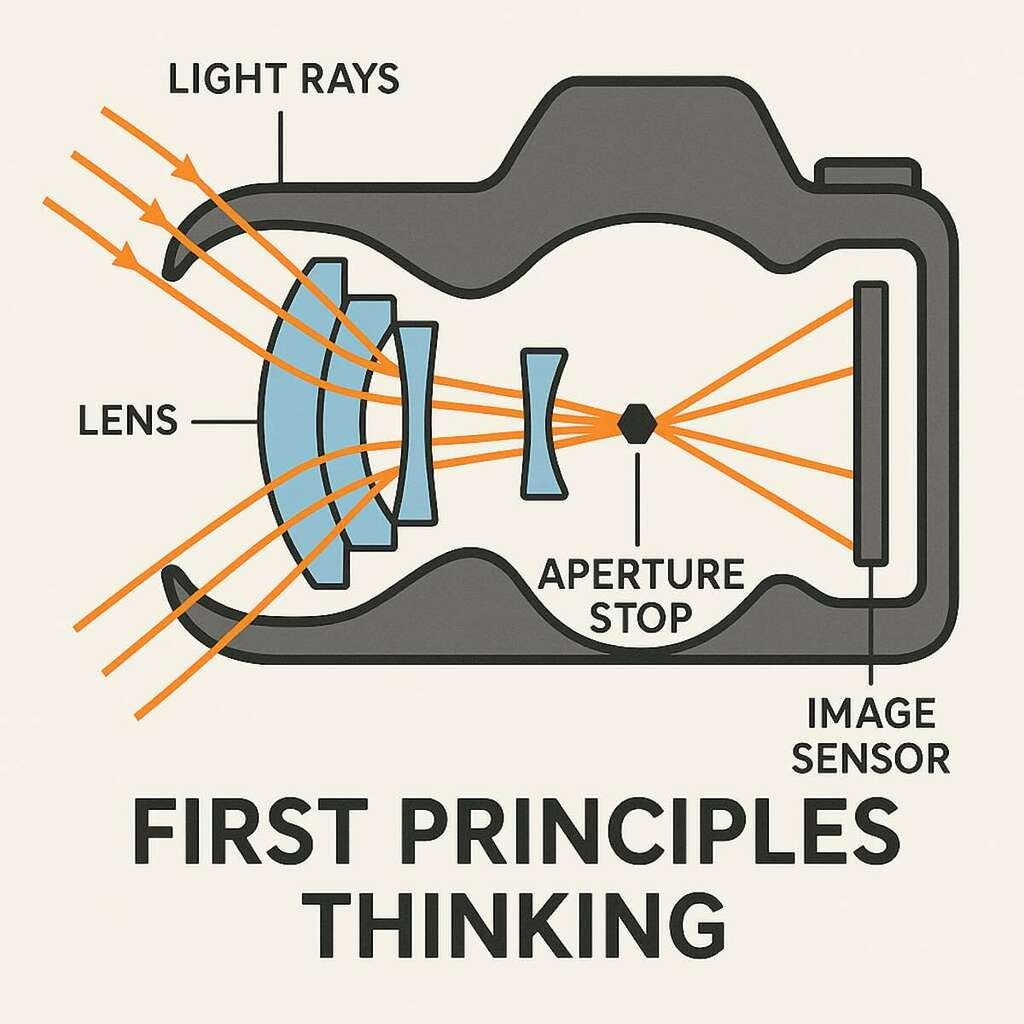
Elon Musk famously used this approach when building SpaceX. Instead of accepting that rockets were inherently expensive, he broke down the cost of rocket components to their raw materials. This revealed that rockets could be built for a fraction of the prevailing price, leading to a revolution in space technology.
How to apply it: When facing a challenging problem, ask yourself: “What are the fundamental truths I know about this situation?” Then rebuild your solution from those basic elements, rather than relying on conventional approaches.
2. Second-Order Thinking
Second-order thinking involves considering the consequences of your actions beyond the immediate results. It’s about asking: “And then what?”
Most people stop at first-order thinking—they consider only the immediate outcomes of their decisions. Second-order thinkers go further, anticipating the ripple effects and unintended consequences that might emerge over time.
How to apply it: Before making an important decision, map out not just the immediate effects, but also the potential second, third, and fourth-order consequences. Ask yourself: “What might happen next? And what might happen after that?”
3. Inversion
Inversion flips problems on their head. Instead of asking, “How do I achieve success?” you ask, “What would guarantee failure, and how do I avoid that?”
This approach, championed by mathematician Carl Jacobi who said “Invert, always invert,” helps identify hidden risks and obstacles that might not be obvious when focusing solely on the positive.
How to apply it: When planning a project, don’t just list what you need to do right—also list everything that would guarantee failure, then make sure you avoid those pitfalls.
4. Circle of Competence
The circle of competence concept reminds us to operate within areas where we have genuine knowledge and expertise. It’s about knowing the boundaries of your knowledge and staying within them.
Warren Buffett attributes much of his success to this principle: “The size of that circle is not very important; knowing its boundaries, however, is vital.”
How to apply it: Make a list of your areas of genuine expertise. When making decisions outside that circle, either invest in learning more or consult experts who have that area within their circle of competence.
5. Probabilistic Thinking
Probabilistic thinking means embracing uncertainty and thinking in terms of odds rather than absolutes. It’s about recognizing that most outcomes in life aren’t certain but fall along a spectrum of probability.
This model helps us make better decisions in uncertain conditions by focusing on the likelihood of different outcomes rather than seeking absolute certainty.
How to apply it: Instead of asking “Will this work?” ask “What’s the probability this will work, and what’s the potential upside versus downside?” This helps you make more nuanced decisions in the face of uncertainty.
6. Occam’s Razor
Occam’s Razor states that when faced with competing explanations, the simplest one is usually correct. It’s a reminder to avoid unnecessary complexity in our thinking.
This principle helps cut through noise and focus on the most likely explanations, saving mental energy and reducing the risk of overthinking.
How to apply it: When analyzing a situation with multiple possible explanations, start with the simplest one that fits the facts. Only move to more complex theories if the simple explanation proves inadequate.
7. Feedback Loops
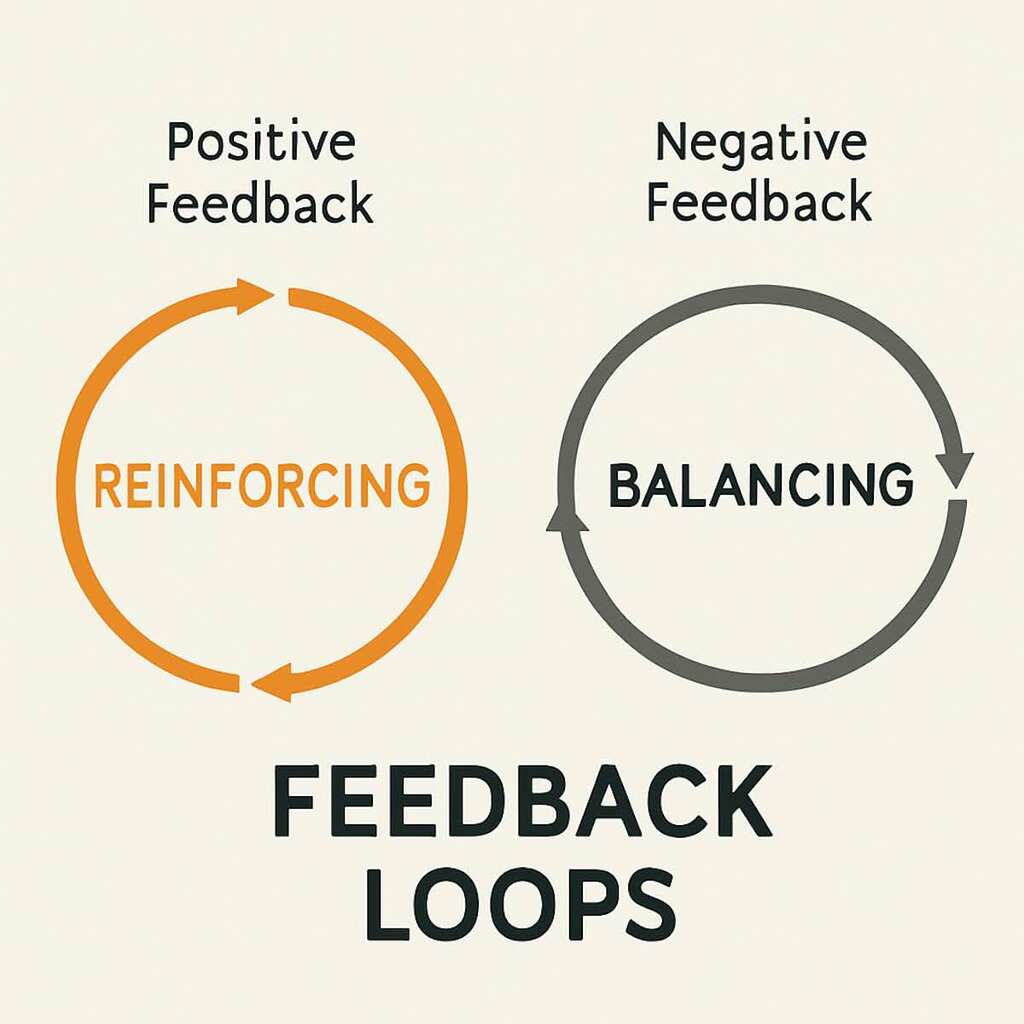
Understanding feedback loops helps explain why some changes amplify over time while others naturally stabilize.
How to apply it: When trying to create lasting change, look for ways to establish positive feedback loops where small improvements lead to even greater improvements over time.
How Mental Models Apply Across Fields
Mental models aren’t just theories. They’re used by successful people in all fields. Startup founders use leverage, while teachers apply second-order thinking.
Being able to think differently in various areas is a huge benefit. It shows how mental models can help you adapt and grow.
Real-World Applications of Mental Models
Mental models aren’t just theoretical concepts—they’re practical tools that can be applied across virtually every domain of life. Here’s how they can transform your approach in different areas:
Business and Career
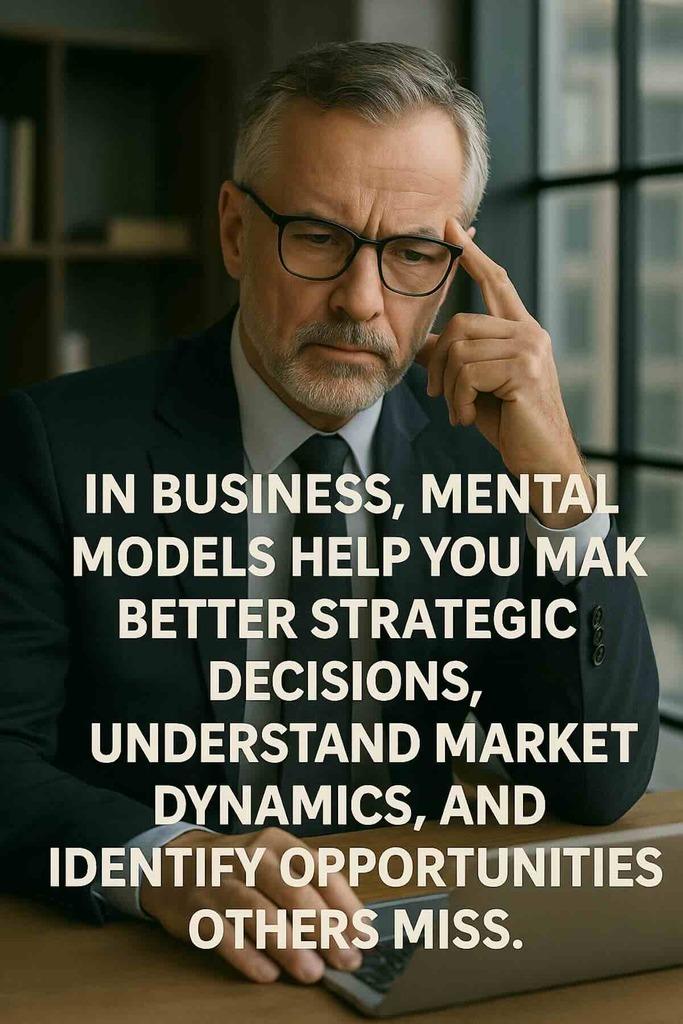
- Leverage: Finding the points where small inputs create outsized results, like identifying which 20% of efforts produce 80% of results
- Opportunity costs: Recognizing that saying “yes” to one opportunity means saying “no” to others
- Network effects: Building products that become more valuable as more people use them
Jeff Bezos uses mental models like “regret minimization” to make big decisions. When deciding whether to start Amazon, he imagined himself at age 80, looking back on his life. Would he regret not taking the chance? This mental model helped him take the leap that led to one of the world’s most valuable companies.
Personal Decision Making
Mental models can dramatically improve your everyday decisions by helping you:
- Avoid common cognitive biases like confirmation bias and sunk cost fallacy
- Make more rational choices about your time, money, and relationships
- Develop better habits by understanding the systems that drive behavior
For example, using the “margin of safety” model from engineering can help you build buffers into your financial planning, ensuring you’re prepared for unexpected expenses or income disruptions.
Science and Learning
Scientists and lifelong learners use mental models to:
- Connect ideas across different domains
- Form more accurate hypotheses
- Identify patterns and anomalies in data
- Build more robust theories that better explain reality
Richard Feynman, the Nobel Prize-winning physicist, was known for his ability to explain complex concepts simply. His “Feynman Technique” for learning—explaining a concept as if teaching it to a child—is itself a powerful mental model for deepening understanding.
Strategies to Build Your Mental Model Toolkit
How to Build Your Mental Models Toolkit
Developing a robust set of mental models isn’t something that happens overnight. It’s a lifelong process of learning, applying, and refining.

1. Study Across Disciplines
The most valuable mental models come from diverse fields. Don’t just stick to your area of expertise. Explore concepts from:
Science & Mathematics
- Physics
- Biology
- Chemistry
- Statistics
Social Sciences
- Psychology
- Economics
- Sociology
- Game Theory
Humanities & Others
- Philosophy
- History
- Engineering
- Systems Thinking
2. Apply Models in Real Situations
Mental models aren’t just for passive understanding—they’re tools to be used. When facing a decision or problem:
- Identify which mental models might apply to the situation
- Try looking at the problem through different models
- Notice how each model reveals different aspects of the situation
- Combine insights from multiple models for a more complete understanding
3. Reflect and Refine
After applying mental models to a situation, take time to reflect:
- Which models were most helpful in this context?
- Did any models lead you astray? Why?
- How might you combine or modify models to be more effective?
- What gaps in your mental toolkit did you discover?
This reflection process helps you refine your understanding and application of mental models over time.
4. Learn from Masters
Study how successful thinkers use mental models in their work. People like:
- Charlie Munger: Known for his “latticework of mental models” approach to investing
- Ray Dalio: Who built his “principles” based on mental models from his investing experience
- Naval Ravikant: Who applies mental models from various disciplines to business and life decisions
“The first principle is that you must not fool yourself — and you are the easiest person to fool.”
The Benefits of Using Multiple Mental Models
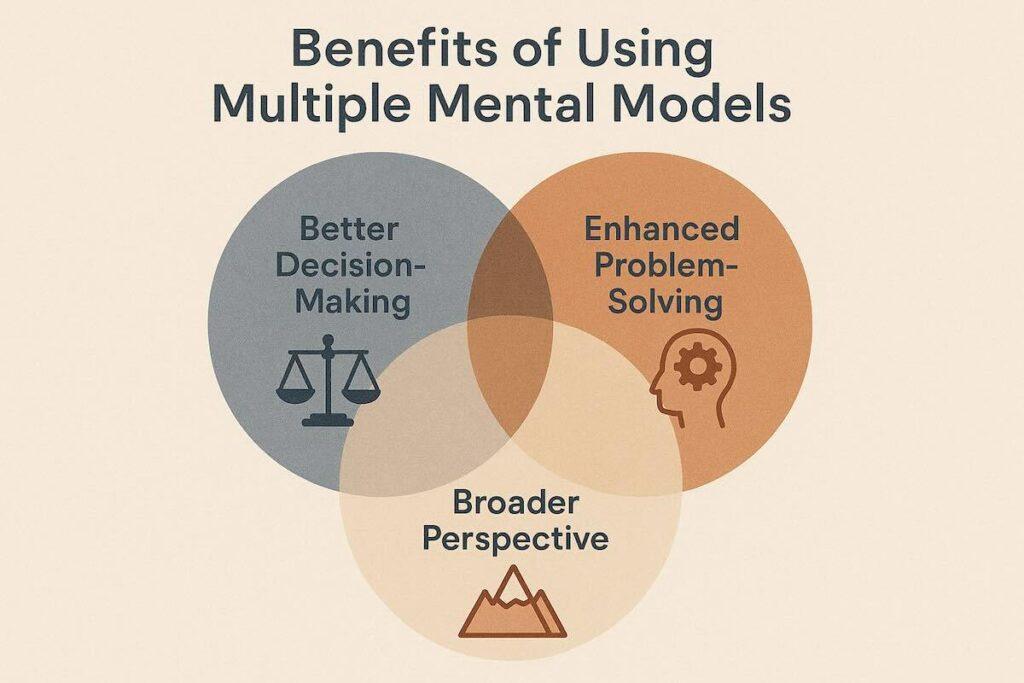
Benefits of Multiple Mental Models
- Clearer thinking: You’ll see problems from multiple angles, revealing insights that would otherwise remain hidden
- Better decisions: You’ll consider more factors and potential outcomes before choosing a course of action
- Reduced bias: Multiple models help counteract the blind spots that come with any single perspective
- Enhanced creativity: Combining models from different fields leads to novel solutions and innovations
- Improved learning: New information connects to your existing mental models, making it easier to understand and remember
- Greater adaptability: You’ll navigate change more effectively by having multiple frameworks to process new situations
Risks of Limited Mental Models
- Tunnel vision: Seeing only what your limited models allow you to see
- Predictable mistakes: Falling into the same thinking traps repeatedly
- Missed opportunities: Failing to recognize valuable chances because they don’t fit your existing frameworks
- Cognitive rigidity: Becoming stuck in outdated ways of thinking
- Poor risk assessment: Underestimating or overestimating risks due to incomplete mental tools
- Difficulty communicating: Struggling to understand perspectives that don’t align with your limited models
The Compounding Effect
Perhaps the most powerful benefit of mental models is how they compound over time. Each new model you learn doesn’t just add to your toolkit—it interacts with your existing models to create new insights and capabilities.
This compounding effect means that the value of your mental models grows exponentially, not linearly. The difference between having 5 mental models and 25 isn’t just 5x—it’s much greater because of the unique combinations and interactions between those models.
“You must know the big ideas in the big disciplines and use them routinely—all of them, not just a few. Most people are trained in one model—economics, for example—and try to solve all problems in one way. You’ve got to have a latticework of models in your head.”
Avoiding Misuse: Pitfalls of Mental Models
Even the strongest frameworks can fail if used wrong. Mistakes often come from forgetting that models are just simplifications. They are not the real thing. Here are some ways to steer clear of these pitfalls.
Common Mistakes When Using Mental Models
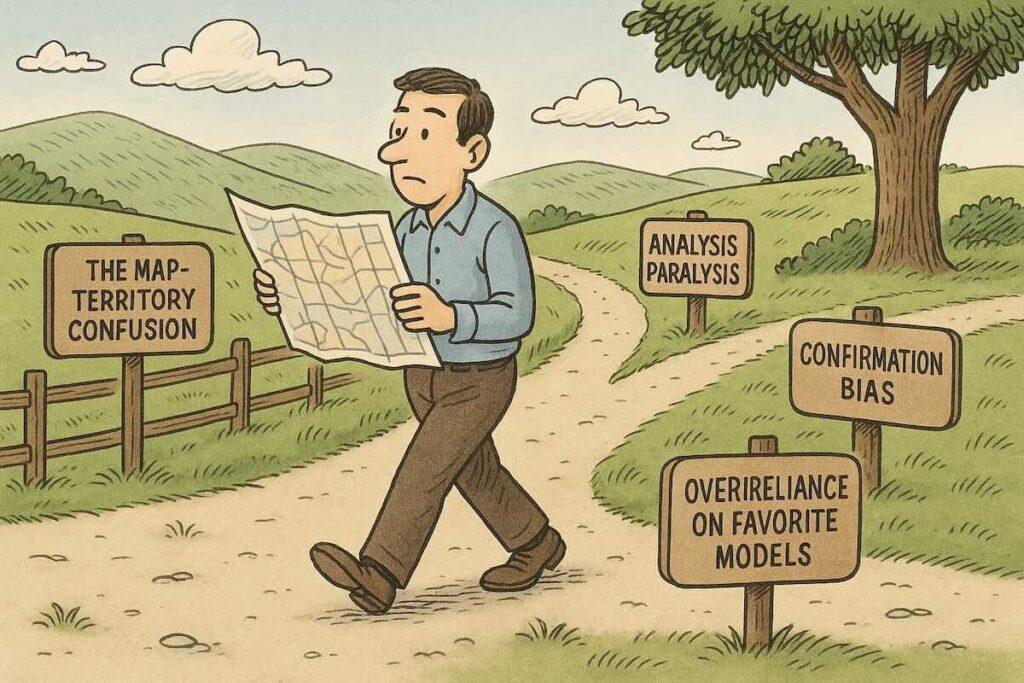
The Map-Territory Confusion
Remember that mental models are maps, not the territory itself. They’re simplifications of reality, not reality itself. When we forget this distinction, we can become overly confident in our models and miss important details that don’t fit our framework.
How to avoid it: Regularly remind yourself that all models are wrong, but some are useful. Be willing to update or discard models when they don’t match reality.
Overreliance on Favorite Models
We all develop favorite mental models that feel comfortable and have worked for us in the past. But overusing these favorites can lead to a “hammer looking for nails” problem, where we try to force situations to fit our preferred models.
How to avoid it: Deliberately try applying different models to each situation, especially ones that feel less familiar or comfortable.
Confirmation Bias
We naturally tend to notice evidence that confirms our existing beliefs and models while overlooking contradictory information. This confirmation bias can reinforce flawed models and prevent us from improving our thinking.
How to avoid it: Actively seek disconfirming evidence. Ask yourself: “What would prove this model wrong?” and look for that evidence.
Analysis Paralysis
With so many mental models available, it’s easy to get caught in endless analysis, applying model after model without ever reaching a decision or taking action.
How to avoid it: Set time limits for your analysis. Remember that the goal of mental models is better decisions and actions, not perfect understanding.
Getting Started: Your Mental Models Action Plan
Ready to upgrade your thinking with mental models? Here’s a practical action plan to get started:
Week 1: Build Your Foundation
- Choose 3-5 models to start with. Begin with versatile models like Second-Order Thinking, Inversion, and Circle of Competence.
- Create a mental models journal. Document each model, its key principles, and potential applications.
- Apply one model each day to a decision or problem you’re facing. Note the insights it provides.
Week 2-4: Expand Your Toolkit
- Add one new model each week from different disciplines (economics, biology, physics, etc.).
- Practice combining models to analyze complex situations from multiple angles.
- Review past decisions through the lens of your new models. What would you have done differently?
Ongoing Practice
- Join a community of mental model thinkers to share insights and applications.
- Read widely across disciplines to discover new models and deepen your understanding of existing ones.
- Teach models to others. Explaining mental models helps solidify your own understanding.
Remember that building your mental models toolkit is a lifelong journey, not a destination. The goal isn’t to memorize hundreds of models but to internalize a diverse set that you can apply fluidly to navigate life’s challenges.
Conclusion: The Path to Better Thinking
Mental models are more than just ideas. They are the hidden structures behind wise decisions and creative insights. By building a diverse mental model toolkit, you tackle life’s challenges with clarity and confidence.
This journey isn’t about mastering every model. It’s about learning the few that matter most for your goals. Using them with intention, your thinking will become more strategic and effective.
So, whether you’re asking What are mental models? or Which ones should I start with?—remember this. The smartest people aren’t born with better brains. They’ve trained themselves to think better. And now, so can you.
Frequently Asked Questions About Mental Models
What’s the difference between mental models and cognitive biases?
Mental models are thinking frameworks that help us understand how things work and make better decisions. They’re tools we consciously apply. Cognitive biases, on the other hand, are unconscious thinking errors that can distort our judgment. Good mental models can actually help us recognize and overcome our cognitive biases.
How many mental models should I learn?
Quality matters more than quantity. Start with 5-10 versatile models that apply across many situations. As you become comfortable with these, gradually add more. Some experts like Charlie Munger suggest having around 100 mental models from various disciplines, but even 20-30 well-understood models can dramatically improve your thinking.
Can mental models be harmful?
Yes, when used improperly. Mental models can reinforce existing biases if we only select models that confirm what we already believe. They can also create overconfidence if we forget that they’re simplifications of reality, not reality itself. The key is to use multiple models and remain open to updating them when evidence suggests they’re incomplete or incorrect.
How do I know which mental model to apply in a given situation?
This comes with practice. Start by asking what type of problem you’re facing. Is it a decision under uncertainty? Try probabilistic thinking. Facing a complex system? Consider feedback loops. Struggling with a difficult challenge? Try inversion. Over time, you’ll develop an intuition for which models are most helpful in different contexts.
